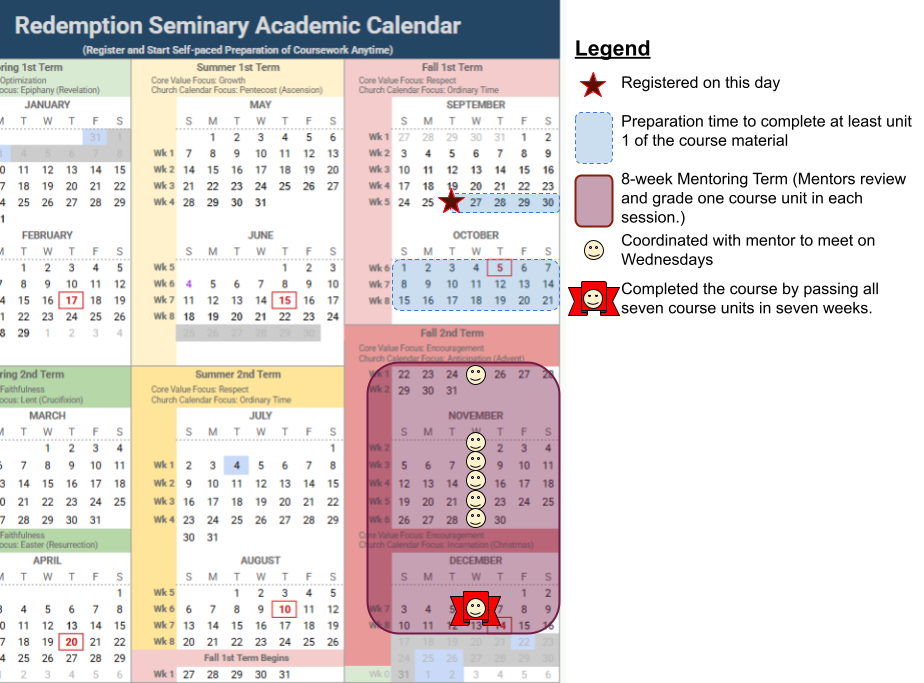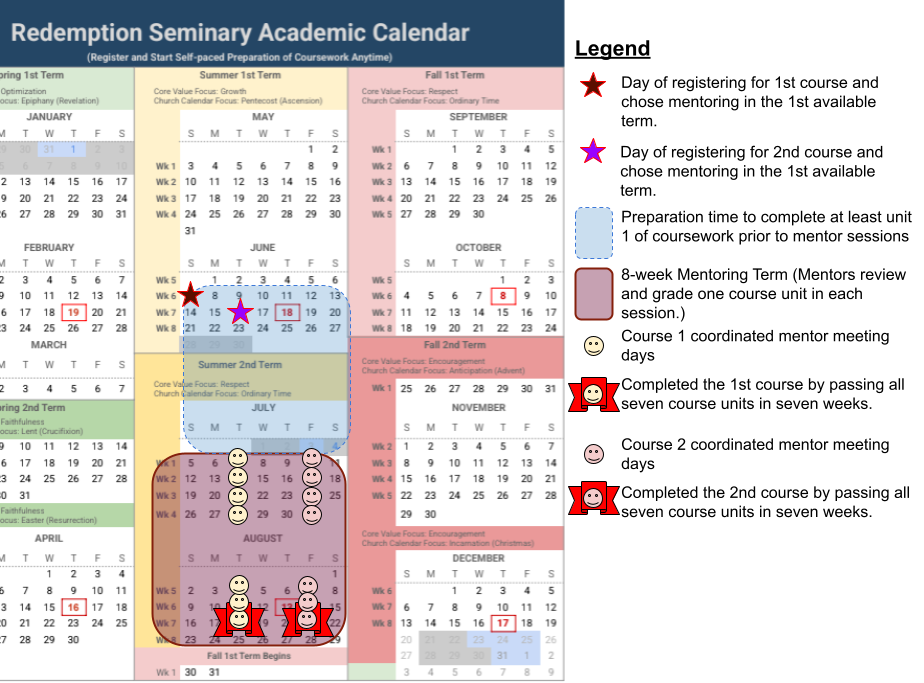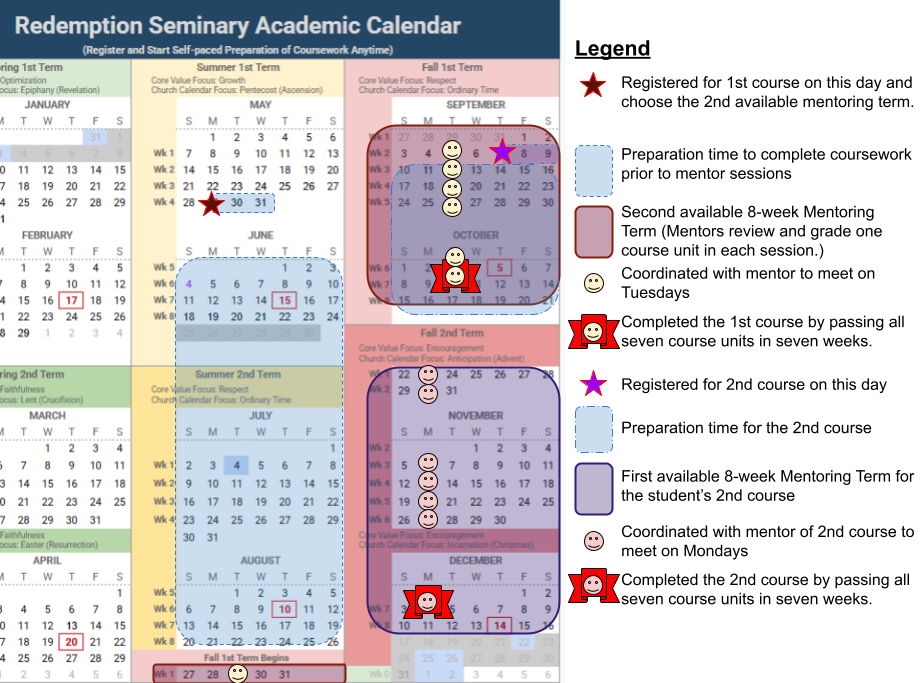
How Courses Work
What You Can Expect
Innovative Course Structure to Accommodate Your Schedule
At Redemption Seminary, we designed our courses to fit around your life and ministry, not the other way around. Here’s how our flexible structure works:
Key Features
Register Anytime: Get immediate access to your coursework and materials.
Self-Paced Prep: Determine the amount of time for preparation before your mentoring term by selecting one of the next two mentoring terms (8-week terms).
Low-Stress Learning: Workbook-based approach instead of high-stakes exams or long papers.
Live Mentor Feedback: Grading is done in real-time through conversation with your mentor.
Application Focused: Workbook and mentoring sessions emphasize applying Scripture to your context.
Affordable: About half the cost of traditional programs, with all resources included.
Frequent Terms: 8-week mentoring terms occur every two months (six per year).
How It Works
1
Registration
Select course,
mentor, and mentoring term
2
Preparation
Prepare before starting your mentoring term
3
Mentoring
Meet with your mentor during the mentoring term
Want to take courses without mentoring? You can apply for the non-graded track to access course materials at any time. (This track doesn’t involve mentoring terms.)
Step 1: Registration (Anytime)
Register at any time of the year and gain instant access to your course materials.
Select your mentor and mentoring term during registration.
Choose either the next term (shorter prep period), or the term after that (longer prep period).
Take breaks between courses if needed after you complete a course — you can delay registration for up to two terms and keep your student status and library access.
Work on more than one course at a time if you prefer.
Step 2: Preparation (Self-Paced Preparation Before Mentoring)
Access to all course materials is provided after payment for the course is received (the first payment for those on a payment plan).
Use your preparation period to work ahead through as many of the seven course units as you wish.
Complete at least Unit 1 before your first mentoring session (we recommend Units 1–3).
Preparation time can be as short as 3 weeks or as long as 19 weeks, depending on when you register and which mentoring term you select.
You may change your scheduled mentoring term up until the end of the first mentoring week (fees apply).
Ongoing access to course materials requires being scheduled for mentoring.
Step 3: Mentoring (8-Week Term)
Meet weekly with your mentor for eight weeks.
One unit of coursework is reviewed each week (Unit 1 in Week 1, Unit 2 in Week 2, etc.).
An optional eighth session is available if you need additional time.
Narrative Examples
All of these examples refer to mentoring terms, which are defined on the academic calendar.
A student registers 4 weeks before Week 1 of the next mentoring term. To complete the course quickly, they chose the next available mentoring term, giving them 4 weeks of prep time. The registration form also offers the option to choose the second available term, which would have given them 12 weeks to prepare — but they preferred to move quickly, completed three units before mentoring began, and finished the rest during the mentoring term.
Single Course with Quick Prep Time
A student registers for a course and schedules mentoring for the next term, then begins coursework. Soon after, they register for a second course and schedule mentoring for it in the same term. They complete each unit for both courses before each mentoring session, finishing all work by Week 7 for both courses.
Two Courses at Once
Lengthy Prep Time, Overlapping Two Courses
A student works at an extended pace (30 minutes a day) and completes all seven units in the preparation time before their first mentoring session. During that first mentoring term, they sign up for a second course. This time, they choose the next available mentoring term (shorter prep period). This allows them to prepare for their second course while completing mentoring for the first.
Changing Scheduled Mentoring
A student registers for a course and schedules mentoring for the next term, but later realizes they need more time. They postponed mentoring to the second term, paying only the mentoring change fee since they acted before the deadline. They complete all seven units and finish the course with seven mentoring sessions.
Overview of Course Change Periods
Competency-based
The goal of learning is to gain competency with a set of skills or area of knowledge. Traditional testing and time-bound terms are not well suited for the acquisition of competencies. Simply put, people acquire new competencies in different ways and at different rates. So course objectives and assessments should be geared around allowing students to demonstrate the desired competencies in their real-life situations. Assignments include real-life applications of the student’s course material. Mentor sessions are when students report on these experiences and demonstrate their current competency. Mentor-professors determine whether students have demonstrated competency with the project objective and should move on to the next project, or whether they need to spend more time building their competency with the current project.
Program Pacing
Program Pacing Examples (Months)
Avg. Daily Study Time (minutes)
Class Size
Redemption Seminary has a new approach to the definition of a “class.” Instead of a set number of students taught by a single instructor (creating a student-teacher ratio), Redemption Seminary has course cohorts, which represent all the students taking a course at the same time and then one-to-one mentoring for each student. The cohort size can be any number, but the student-teacher ratio is always 1:1. This allows students to see and interact with cohort comments from students from all sorts of backgrounds, locations, and contexts while maximizing very personal live interactions with their mentor-professor.
Recorded and Transcribed Lectures
The lecture hall (traditional classroom) is not an efficient way to deliver information or to effectively use meeting time. Listening to a monologue doesn’t require a live meeting. Meeting together in live contexts is the most precious part of education, so we use the masterclass format with live one-to-one mentor sessions. Lectures are significant, so we recorded and transcribed the top scholars teaching in their fields of expertise. This way, your notes can serve as commentary and reflections rather than a transcription.




